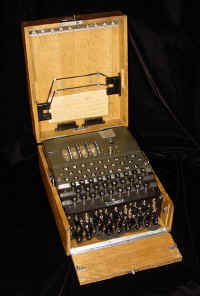
[click on image to expand]
[go to the bottom of this page for more Enigma links]
The
Enigma machine

[click on image to expand]
Background:
The German Enigma is surely the best known of the WW2 cipher machines used by either side
in the conflict. Invented in 1918, it was developed as both a commercial and military
encipherment system before and during the war. Enigma is an electro-mechanical device that
utilizes a stepping wheel system to 'scramble' a plaintext message to produce ciphertext
via polyalphabetic substitution. Potentially, the number of ciphertext alphabets is
astronomically large - a fact that led the German military authorities to believe, wrongly as it turned out, in the absolute security of this cipher system.
Enigma
- principle:
Enigma's output is a very complex polyalphabetic substitution ciphertext. The 3-wheel
Service Enigma consists of a number of components. A message to be enciphered is input
from a keyboard - QWERTZUIO layout. The signal leaves the keyboard and passes through a
plugboard where, if the plugboard socket contains a connector, its identity is switched in
a monoalphabetic substitution. If the particular socket does not contain a plug, the
identity of the input character is unchanged. The plugboard substitution is reciprocal
- i.e. if A is switched to Z, then Z is switched to A, a weakness that was to be exploited
by Allied cryptanalysts.
After passing through all three
wheels the signal reaches the reflector which performs two functions - it changes the
signal's identity once again and also sends it back, in the reverse direction, through the
three wheels to the entry stator. From here it passes back to the plugboard and then to
the lampboard where a lamp corresponding to the now enciphered character is illuminated.
Because of the reflector's function in the encipherment process, no plaintext character
can ever encipher to itself - another weakness in the system that was exploited to great
effect by the Allied cryptanalysts.
Ringstellung: After setting the index ring on each, the three wheels were arranged on the machine's spindle in the order prescribed in the daily [or other periodic] instructions for machine initialization.
Steckerbrett: The plugboard was set up according to the same instructions. Normally, ten sets of plugs were used leaving six letters 'self-steckered'.
The internal lid of the Enigma was closed and the wheels set to the initial position.
Enigma was then ready for use.
Mathematical note: NSA's Dr. A. Ray Miller is the author of a thin booklet entitled: "The Cryptographic Mathematics of Enigma" in which he shows that the total number of possible set-up states - the so-called cryptovariable space - for a standard three-wheel German army Enigma is approximately 1023 or 1 followed by twenty-three zeros: about one hundred thousand billion billion! The figure for the four-wheel naval Enigma M4 was even greater. German cryptologists believed the Enigma cipher to be unbreakable.
Enigma - a German & English glossary
Enigma - download internal wiring information
Further reading - a bibliography
Enigma machines - known locations
Enigma and NEMA - selling prices